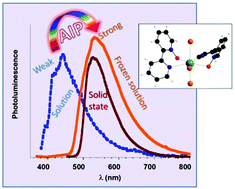Aggregation induced phosphorescent N-oxyde-2,2′-bipyridine bismuth complexes and polymorphism-dependent emission†
Abstract
Unprecedented bismuth complexes, based on the rarely used ditopic ligand N-oxide-2,2′-bipyridine (bp2mo), crystallizing as three polymorphs, α- (1), β- (2) and γ-[BiBr3(bp2mo)2] (3), exhibit phosphorescence with a quantum yield up to 17% for the crystal phase (1), while the complex displays a weak fluorescence in solution. A study of the luminescence properties combined with DFT/TDDFT calculations reveals that the lighting phenomenon originated by aggregation induced phosphorescence correlated with the weak intermolecular interactions present in the different crystal phases.


 Please wait while we load your content...
Please wait while we load your content...